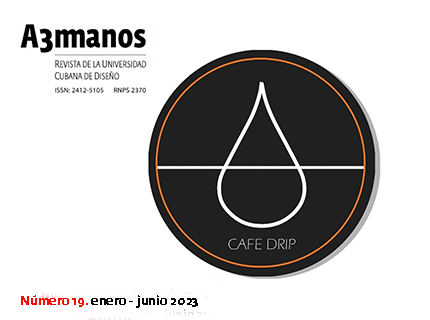Inflection of polyhedra.
##plugins.themes.bootstrap3.article.main##
Abstract
The polyhedrons prove to be an inexhaustible source of resources for the generation of shapes, transcending their existence as a mere catalog of stagnant shapes. On the other hand, it is possible to verify the presence of these forms in design objects, in a more explicit or subtle way, evident proof of their continuous validity. From the contributions of morphology in the field of object design, it is intended to investigate the potential of polyhedrons, and their intervention from new transformation operations as a starting point for the conception and generation of forms. In this sense, the present work exposes the experience around the "inflection of polyhedra", a morphogenerative resource for the production of shapes and whose essence is related to the convex nature of regular polyhedra. This exhibition is made up of two results: the first refers to a didactic experience and the enormous potential of the resource for the production of forms in initial stages of learning; the second, to the research project that emerged as a consequence of the first experiences, and whose objective was to understand and analyze the attributes of the forms generated from this morphological resource used.
##plugins.themes.bootstrap3.article.details##

This work is licensed under a Creative Commons Attribution-NonCommercial-ShareAlike 4.0 International License.
- Attribution — You must give appropriate credit , provide a link to the license, and indicate if changes were made . You may do so in any reasonable manner, but not in any way that suggests the licensor endorses you or your use.
- NonCommercial — You may not use the material for commercial purposes .
- No additional restrictions — You may not apply legal terms or technological measures that legally restrict others from doing anything the license permits.
- ShareAlike — If you remix, transform, or build upon the material, you must distribute your contribution under the same license as the original. NOTE: This point applies to numbers 1 to 20 of the magazine with the previous CC-BY-NC-SA 4.0 license. Does not apply to the new CC BY-NC 4.0 license from Volume 11, Number. 21 (2024).
References
Galán, J.; Gual, y otros (2010). El diseño industrial en España. Madrid: Cátedra.
Martín Fernández, M. (2005). ¿Cómo medir el progreso de una Economía basada en el conoci-miento? pág. 52-72, en el libro Cuba crecer desde el conocimiento. La Habana: Editorial Ciencias So-ciales.
Medina, N y otros (2006). Gestión de Ciencia e Innovación Tecnológica en las universidades. La experiencia cubana. La Habana: Editorial Félix Varela.
Núñez Jover, J, y otros (2006). La gestión del cono-cimiento, la ciencia, la tecnología y la innovación de la nueva universidad: una aproximación con-ceptual en la nueva universidad. P5-20, en el libro. La universidad cubana y su contribución a la uni-versalización del conocimiento. La Habana: Edito-rial Félix Varela.
Ojeda Suárez, R (2006). Gestión del conocimiento en el desarrollo local. p 21-31, en el libro La univer-sidad cubana y su contribución a la universaliza-ción del conocimiento. La Habana: Editorial Félix Varela.
Sommerville, I (2005). Ingeniería del software (séptima edición). Madrid, España: Pearson Edu-cación.
Torrent, R y Marín, J M. (2005). Historia del diseño industrial. Escuela politécnica de Madrid.
Torres Pérez, R. (2005). Experiencias de países en el diseño de políticas orientadas hacia la econo-mía del conocimiento: casos de estudios: Malasia y Viet Nam, en el libro Cuba crecer desde el cono-cimiento. La Habana: Editorial Ciencias Sociales.
Triana Cordovi, J (2005). Compartir el conoci-miento para crecer: las consultorías y el creci-miento macroeconómico, en el libro Cuba crecer desde el conocimiento. La Habana: Editorial Cien-cias Sociales.

























